A Study on the Relationship between Campus Environment and College Students’ Emotional Perception: A Case Study of Yuelu Mountain National University Science and Technology City
Abstract
:1. Introduction
1.1. Background
1.2. Literature Review
2. Materials and Methods
2.1. Research Framework
2.2. Research Data
2.2.1. Study Area
2.2.2. Research Data
2.3. Research Methodology
2.3.1. DeepLab v3+
2.3.2. MaxDiff Perceptual Quantization and the XGBoost Prediction Model
2.3.3. Spatial Autocorrelation Analysis of Emotional Perception
3. Results
3.1. Campus Environment Image Semantic Segmentation Results
3.2. Predictive Maps for Emotional Perception
3.3. Results of Correlation Analysis
4. Discussion
4.1. Natural Environment and Emotional Perception
4.2. Built Environment and Emotional Perception
4.3. Disciplinary Environment and Emotional Perception
4.4. Campus Planning and Emotional Perception
5. Conclusions
5.1. Environmental Perception and Quantification of Emotions
5.2. Limitations
Author Contributions
Funding
Data Availability Statement
Conflicts of Interest
References
- Chen, J.; Chen, S.; Landry, P.F.; Davis, D.S. How Dynamics of Urbanization Affect Physical and Mental Health in Urban China. China Q. 2014, 220, 988–1011. [Google Scholar] [CrossRef]
- Chen, J.; Chen, S. Mental health effects of perceived living environment and neighborhood safety in urbanizing China. Habitat Int. 2015, 46, 101–110. [Google Scholar] [CrossRef]
- Li, J.; Liu, Z.L. Housing stress and mental health of migrant populations in urban China. Cities 2018, 81, 172–179. [Google Scholar] [CrossRef]
- Dong, G.P.; Wolf, L.; Alexiou, A.; Arribas-Bel, D. Inferring neighbourhood quality with property transaction records by using a locally adaptive spatial multi-level model. Comput. Environ. Urban Syst. 2019, 73, 118–125. [Google Scholar] [CrossRef]
- Zhang, H.; Chen, B.; Sun, Z.; Bao, Z.Y. Landscape perception and recreation needs in urban green space in Fuyang, Hangzhou, China. Urban For. Urban Green. 2013, 12, 44–52. [Google Scholar] [CrossRef]
- Özgüner, H.; Eraslan, S.; Yilmaz, S. Public perception of landscape restoration along a degraded urban streamside. Land Degrad. Dev. 2012, 23, 24–33. [Google Scholar] [CrossRef]
- Rollero, C.; De Piccoli, N. Place attachment, identification and environment perception: An empirical study. J. Environ. Psychol. 2010, 30, 198–205. [Google Scholar] [CrossRef]
- Mehrabian, A.; Russell, J.A. An Approach to Environmental Psychology; The MIT Press: Cambridge, MA, USA, 1974; ISBN 978-026-213-090-5. [Google Scholar]
- Zhu, Y.G.; Jones, K.C. Urbanisation and health in China. Lancet 2010, 376, 232–233. [Google Scholar] [CrossRef]
- Grekousis, G.; Liu, Y. Where will the next emergency event occur? Predicting ambulance demand in emergency medical services using artificial intelligence. Comput. Environ. Urban Syst. 2019, 76, 110–122. [Google Scholar] [CrossRef]
- Chen, C.X.; Li, H.W.; Luo, W.J.; Xie, J.H.; Yao, J.; Wu, L.F.; Xia, Y. Predicting the effect of street environment on residents’ mood states in large urban areas using machine learning and street view images. Sci. Total Environ. 2022, 816, 151605. [Google Scholar] [CrossRef]
- Meng, Y.M.; Li, Q.Y.; Ji, X.; Yu, Y.Q.; Yue, D.; Gan, M.Q.; Wang, S.Y.; Niu, J.N.; Fukuda, H. Research on Campus Space Features and Visual Quality Based on Street View Images: A Case Study on the Chongshan Campus of Liaoning University. Buildings 2023, 13, 1332. [Google Scholar] [CrossRef]
- Rui, Q.Q.; Cheng, H.S. Quantifying the spatial quality of urban streets with open street view images: A case study of the main urban area of Fuzhou. Ecol. Indic. 2023, 156, 111204. [Google Scholar] [CrossRef]
- Tang, J.X.; Long, Y. Measuring visual quality of street space and its temporal variation: Methodology and its application in the Hutong area in Beijing. Landsc. Urban Plan. 2019, 191, 103436. [Google Scholar] [CrossRef]
- Hickman, C. ‘To brighten the aspect of our streets and increase the health and enjoyment of our city’: The National Health Society and urban green space in late-nineteenth century London. Landsc. Urban Plan. 2013, 118, 112–119. [Google Scholar] [CrossRef]
- Carmona, M.; Gabrieli, T.; Hickman, R.; Laopoulou, T.; Livingstone, N. Street appeal: The value of street improvements. Prog. Plan. 2018, 126, 1–51. [Google Scholar] [CrossRef]
- Wang, L.; Han, X.; He, J.; Jung, T. Measuring residents’ perceptions of city streets to inform better street planning through deep learning and space syntax. Isprs J. Photogramm. Remote Sens. 2022, 190, 215–230. [Google Scholar] [CrossRef]
- Ulrich, R.S.; Simons, R.F.; Losito, B.D.; Fiorito, E.; Miles, M.A.; Zelson, M. Stress recovery during exposure to natural and urban environments. J. Environ. Psychol. 1991, 11, 201–230. [Google Scholar] [CrossRef]
- Kaplan, S. The restorative benefits of nature: Toward an integrative framework. J. Environ. Psychol. 1995, 15, 169–182. [Google Scholar] [CrossRef]
- Dong, H.W.; Qin, B. Exploring the link between neighborhood environment and mental wellbeing: A case study in Beijing, China. Landsc. Urban Plan. 2017, 164, 71–80. [Google Scholar] [CrossRef]
- Helbich, M. Toward dynamic urban environmental exposure assessments in mental health research. Environ. Res. 2018, 161, 129–135. [Google Scholar] [CrossRef]
- Hidalgo, A.K. Mental health in winter cities: The effect of vegetation on streets. Urban For. Urban Green. 2021, 63, 127226. [Google Scholar] [CrossRef]
- Marselle, M.R.; Bowler, D.E.; Watzema, J.; Eichenberg, D.; Kirsten, T.; Bonn, A. Urban street tree biodiversity and antidepressant prescriptions. Sci. Rep. 2020, 10, 22445. [Google Scholar] [CrossRef] [PubMed]
- Taylor, M.S.; Wheeler, B.W.; White, M.P.; Economou, T.; Osborne, N.J. Research note: Urban street tree density and antidepressant prescription rates A cross-sectional study in London, UK. Landsc. Urban Plan. 2015, 136, 174–179. [Google Scholar] [CrossRef]
- Zhao, J.W.; Wu, J.X.; Wang, H.D. Characteristics of urban streets in relation to perceived restorativeness. J. Expo. Sci. Environ. Epidemiol. 2020, 30, 309–319. [Google Scholar] [CrossRef]
- Ma, J.; Li, C.; Kwan, M.-P.; Kou, L.; Chai, Y. Assessing personal noise exposure and its relationship with mental health in Beijing based on individuals’ space-time behavior. Environ. Int. 2020, 139, 105737. [Google Scholar] [CrossRef]
- Van den Berg, A.E.; Jorgensen, A.; Wilson, E.R. Evaluating restoration in urban green spaces: Does setting type make a difference? Landsc. Urban Plan. 2014, 127, 173–181. [Google Scholar] [CrossRef]
- Wang, X.X.; Rodiek, S.; Wu, C.Z.; Chen, Y.; Li, Y.X. Stress recovery and restorative effects of viewing different urban park scenes in Shanghai, China. Urban For. Urban Green. 2016, 15, 112–122. [Google Scholar] [CrossRef]
- Nordbo, E.C.A.; Nordh, H.; Raanaas, R.K.; Aamodt, G. GIS-derived measures of the built environment determinants of mental health and activity participation in childhood and adolescence: A systematic review. Landsc. Urban Plan. 2018, 177, 19–37. [Google Scholar] [CrossRef]
- Li, J.J.; Jin, Y.C.; Lu, S.; Wu, W.; Wang, P.F. Building environment information and human perceptual feedback collected through a combined virtual reality (VR) and electroencephalogram (EEG) method. Energy Build. 2020, 224, 110259. [Google Scholar] [CrossRef]
- Ojha, V.K.; Griego, D.; Kuliga, S.; Bielik, M.; Bus, P.; Schaeben, C.; Treyer, L.; Standfest, M.; Schneider, S.; König, R.; et al. Machine learning approaches to understand the influence of urban environments on human’s physiological response. Inf. Sci. 2019, 474, 154–169. [Google Scholar] [CrossRef]
- Zhang, F.; Zhou, B.L.; Liu, L.; Liu, Y.; Fung, H.H.; Lin, H.; Ratti, C. Measuring human perceptions of a large-scale urban region using machine learning. Landsc. Urban Plan. 2018, 180, 148–160. [Google Scholar] [CrossRef]
- Salesses, P.; Schechtner, K.; Hidalgo, C.A. The Collaborative Image of The City: Mapping the Inequality of Urban Perception. PLoS ONE 2013, 8, e68400, Erratum in PLoS ONE 2015, 10, e0119352. [Google Scholar] [CrossRef] [PubMed]
- Jiang, B.; Xu, W.Y.; Ji, W.Q.; Kim, G.; Pryor, M.; Sullivan, W.C. Impacts of nature and built acoustic-visual environments on human’s multidimensional mood states: A cross-continent experiment. J. Environ. Psychol. 2021, 77, 101659. [Google Scholar] [CrossRef]
- Wang, R.Y.; Liu, Y.; Lu, Y.; Zhang, J.B.; Liu, P.H.; Yao, Y.; Grekousis, G. Perceptions of built environment and health outcomes for older Chinese in Beijing: A big data approach with street view images and deep learning technique. Comput. Environ. Urban Syst. 2019, 78, 101386. [Google Scholar] [CrossRef]
- Kuo, F.E.; Sullivan, W.C. Environment and Crime in the Inner City: Does Vegetation Reduce Crime? Environ. Behav. 2001, 33, 343–367. [Google Scholar] [CrossRef]
- Gascon, M.; Triguero-Mas, M.; Martínez, D.; Dadvand, P.; Forns, J.; Plasència, A.; Nieuwenhuijsen, M.J. Mental Health Benefits of Long-Term Exposure to Residential Green and Blue Spaces: A Systematic Review. Int. J. Environ. Res. Public Health 2015, 12, 4354–4379. [Google Scholar] [CrossRef]
- Rundle, A.G.; Bader, M.D.M.; Richards, C.A.; Neckerman, K.M.; Teitler, J.O. Using Google Street View to Audit Neighborhood Environments. Am. J. Prev. Med. 2011, 40, 94–100. [Google Scholar] [CrossRef]
- Mahmoud, J.S.R.; Staten, R.; Hall, L.A.; Lennie, T.A. The relationship among young adult college students’ depression, anxiety, stress, demographics, life satisfaction, and coping styles. Issues Ment. Health Nurs. 2012, 33, 149–156. [Google Scholar] [CrossRef]
- Shamsuddin, K.; Fadzil, F.; Ismail, W.S.W.; Shah, S.A.; Omar, K.; Muhammad, N.A.; Jaffar, A.; Ismail, A.; Mahadevan, R. Correlates of depression, anxiety and stress among Malaysian university students. Asian J. Psychiatry 2013, 6, 318–323. [Google Scholar] [CrossRef]
- Zeisel, J. Inquiry by Design: Tools for Environment-Behavior Research; W.W. Norton & Company: New York, NY, USA, 2006. [Google Scholar]
- Evans, G.W.; Johnson, D. Stress and Open-Office Noise. J. Appl. Psychol. 2000, 85, 779–783. [Google Scholar] [CrossRef]
- Montgomery, C. Happy City: Transforming Our Lives Through Urban Design; Farrar, Straus and Giroux: New York, NY, USA, 2013. [Google Scholar]
- Dubey, A.; Naik, N.; Parikh, D.; Raskar, R.; Hidalgo, C.A. Deep Learning the City: Quantifying Urban Perception at a Global Scale. In Proceedings of the 14th European Conference on Computer Vision (ECCV), Amsterdam, The Netherlands, 8–16 October 2016; pp. 196–212. [Google Scholar]
- Roberts, H.; van Lissa, C.; Hagedoorn, P.; Kellar, I.; Helbich, M. The effect of short-term exposure to the natural environment on depressive mood: A systematic review and meta-analysis. Environ. Res. 2019, 177, 108606. [Google Scholar] [CrossRef] [PubMed]
- Carroll, J.M. Human-computer interaction: Psychology as a science of design. Annu. Rev. Psychol. 1997, 48, 61–83. [Google Scholar] [CrossRef] [PubMed]
- Zhang, J.; Yang, Z.; Chen, Z.; Guo, M.; Guo, P. Optimizing Urban Forest Landscape for Better Perceptions of Positive Emotions. Forests 2021, 12, 1691. [Google Scholar] [CrossRef]
- Gross, J.J.; Muñoz, R.F. Emotion regulation and mental health. Clin. Psychol. Sci. Pract. 1995, 2, 151–164. [Google Scholar] [CrossRef]
- World Health Organization. Green and Blue Spaces and Mental Health: New Evidence and Perspectives for Action; WHO Regional Office for Europe: Copenhagen, Denmark, 2021. [Google Scholar]
- Yao, T.; Lin, W.; Bao, Z.; Zeng, C. Natural or balanced? The physiological and psychological benefits of window views with different proportions of sky, green space, and buildings. Sustain. Cities Soc. 2024, 104, 105293. [Google Scholar] [CrossRef]
- Kaparias, I.; Hirani, J.; Bell, M.G.H.; Mount, B. Pedestrian Gap Acceptance Behavior in Street Designs with Elements of Shared Space. Transp. Res. Rec. 2016, 2586, 17–27. [Google Scholar] [CrossRef]
- Zhao, W.; Tan, L.; Niu, S.; Qing, L. Assessing the Impact of Street Visual Environment on the Emotional Well-Being of Young Adults through Physiological Feedback and Deep Learning Technologies. Buildings 2024, 14, 1730. [Google Scholar] [CrossRef]
- Amleh, D.; Halawani, A.; Haj Hussein, M. Simulation-Based Study for Healing Environment in Intensive Care Units: Enhancing Daylight and Access to View, Optimizing an ICU Room in Temperate Climate, the Case Study of Palestine. Ain Shams Eng. J. 2023, 14, 101868. [Google Scholar] [CrossRef]
- Akalin, A.; Yildirim, K.; Wilson, C.; Kilicoglu, O. Architecture and engineering students’ evaluations of house façades: Preference, complexity and impressiveness. J. Environ. Psychol. 2009, 29, 124–132. [Google Scholar] [CrossRef]
- Hovy, E.H. What Are Sentiment, Affect, and Emotion? Applying the Methodology of Michael Zock to Sentiment Analysis. In Language Production, Cognition, and the Lexicon; Springer: Cham, Switzerland, 2015; pp. 13–24. [Google Scholar] [CrossRef]
- Cambria, E. Affective Computing and Sentiment Analysis. IEEE Intell. Syst. 2016, 31, 102–107. [Google Scholar] [CrossRef]
- Yadollahi, A.; Shahraki, A.G.; Zaiane, O.R. Current State of Text Sentiment Analysis from Opinion to Emotion Mining. ACM Comput. Surv. 2017, 50, 1–33. [Google Scholar] [CrossRef]
- Cambria, E.; Das, D.; Bandyopadhyay, S.; Feraco, A. Affective Computing and Sentiment Analysis. In A Practical Guide to Sentiment Analysis; Springer: Cham, Switzerland, 2017; pp. 1–10. [Google Scholar] [CrossRef]
- Hu, G.; Lu, G.; Zhao, Y. FSS-GCN: A Graph Convolutional Networks with Fusion of Semantic and Structure for Emotion Cause Analysis. Knowl.-Based Syst. 2021, 212, 106584. [Google Scholar] [CrossRef]
- Ye, Y.; Zhang, Z.; Zhang, X.; Zeng, W. Human-Scale Quality on Streets: A Large-Scale and Efficient Analytical Approach Based on Street View Images and New Urban Analytical Tools. Urban Plan. Int. 2019, 34, 18–27. [Google Scholar] [CrossRef]
- Nagata, S.; Nakaya, T.; Hanibuchi, T.; Amagasa, S.; Kikuchi, H.; Inoue, S. Objective scoring of streetscape walkability related to leisure walking: Statistical modeling approach with semantic segmentation of Google Street View images. Health Place 2020, 66, 102428. [Google Scholar] [CrossRef] [PubMed]
- Ewing, R.; Handy, S. Measuring the Unmeasurable: Urban Design Qualities Related to Walkability. J. Urban Des. 2009, 14, 65–84. [Google Scholar] [CrossRef]
- Zheng, X.; Amemiya, M. Method for Applying Crowdsourced Street-Level Imagery Data to Evaluate Street-Level Greenness. Isprs Int. J. Geo-Inf. 2023, 12, 108. [Google Scholar] [CrossRef]
- Pendola, R.; Gen, S. Does “Main Street” Promote Sense of Community? A Comparison of San Francisco Neighborhoods. Environ. Behav. 2008, 40, 545–574. [Google Scholar] [CrossRef]
- Harvey, C.; Aultman-Hall, L.; Hurley, S.E.; Troy, A. Effects of skeletal streetscape design on perceived safety. Landsc. Urban Plan. 2015, 142, 18–28. [Google Scholar] [CrossRef]
- Ramirez, T.; Hurtubia, R.; Lobel, H.; Rossetti, T. Measuring heterogeneous perception of urban space with massive data and machine learning: An application to safety. Landsc. Urban Plan. 2021, 208, 104002. [Google Scholar] [CrossRef]
- Gonzalez, D.; Rueda-Plata, D.; Acevedo, A.B.; Duque, J.C.; Ramos-Pollán, R.; Betancourt, A.; García, S.J.B. Environment, Automatic detection of building typology using deep learning methods on street level images. Build. Environ. 2020, 177, 106805. [Google Scholar] [CrossRef]
- Chen, L.-C.; Papandreou, G.; Kokkinos, I.; Murphy, K.; Yuille, A.L. DeepLab: Semantic Image Segmentation with Deep Convolutional Nets, Atrous Convolution, and Fully Connected CRFs. IEEE Trans. Pattern Anal. Mach. Intell. 2018, 40, 834–848. [Google Scholar] [CrossRef] [PubMed]
- Chen, L.-C.; Zhu, Y.; Papandreou, G.; Schroff, F.; Adam, H. Encoder-decoder with atrous separable convolution for semantic image segmentation. In Proceedings of the European Conference on Computer Vision (ECCV), Munich, Germany, 8–14 September 2018; pp. 801–818. [Google Scholar]
- Moran, P.A.P. The Interpretation of Statistical Maps. J. R. Stat. Soc. Ser. B 1948, 10, 243–251. [Google Scholar] [CrossRef]
- Lu, Y. Using Google Street View to Investigate the Association between Street Greenery and Physical Activity. Landsc. Urban Plan. 2019, 191, 103435. [Google Scholar] [CrossRef]
- Badrinarayanan, V.; Kendall, A.; Cipolla, R. SegNet: A Deep Convolutional Encoder-Decoder Architecture for Image Segmentation. IEEE Trans. Pattern Anal. Mach. Intell. 2017, 39, 2481–2495. [Google Scholar] [CrossRef] [PubMed]
- Shao, Y.; Yin, Y.; Xue, Z.; Ma, D. Assessing and Comparing the Visual Comfort of Streets across Four Chinese Megacities Using AI-Based Image Analysis and the Perceptive Evaluation Method. Land 2023, 12, 834. [Google Scholar] [CrossRef]
- Jiang, X.; Larsen, L.; Sullivan, W. Connections Between Daily Greenness Exposure and Health Outcomes. Int. J. Environ. Res. Public Health 2020, 17, 3965. [Google Scholar] [CrossRef]
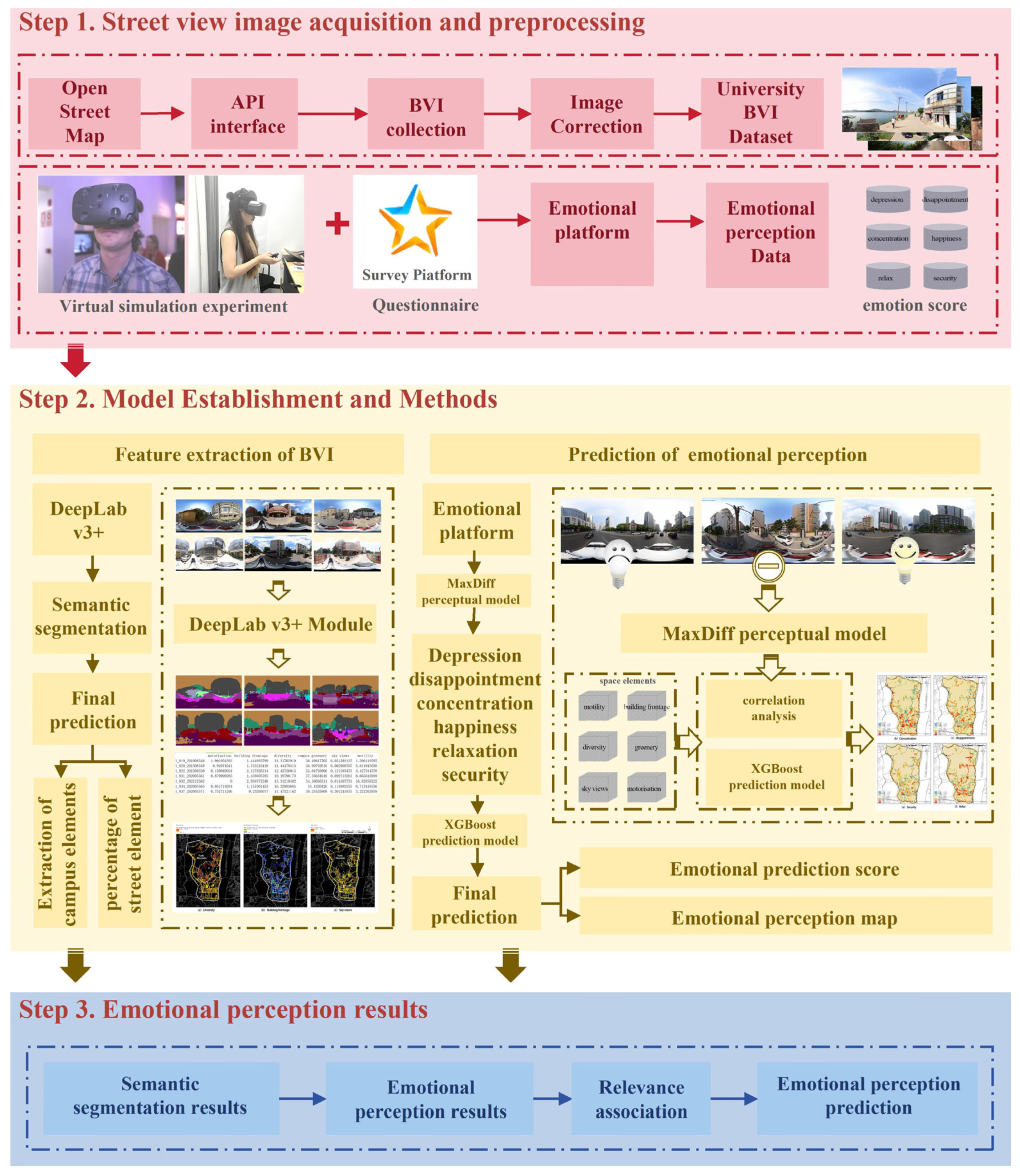

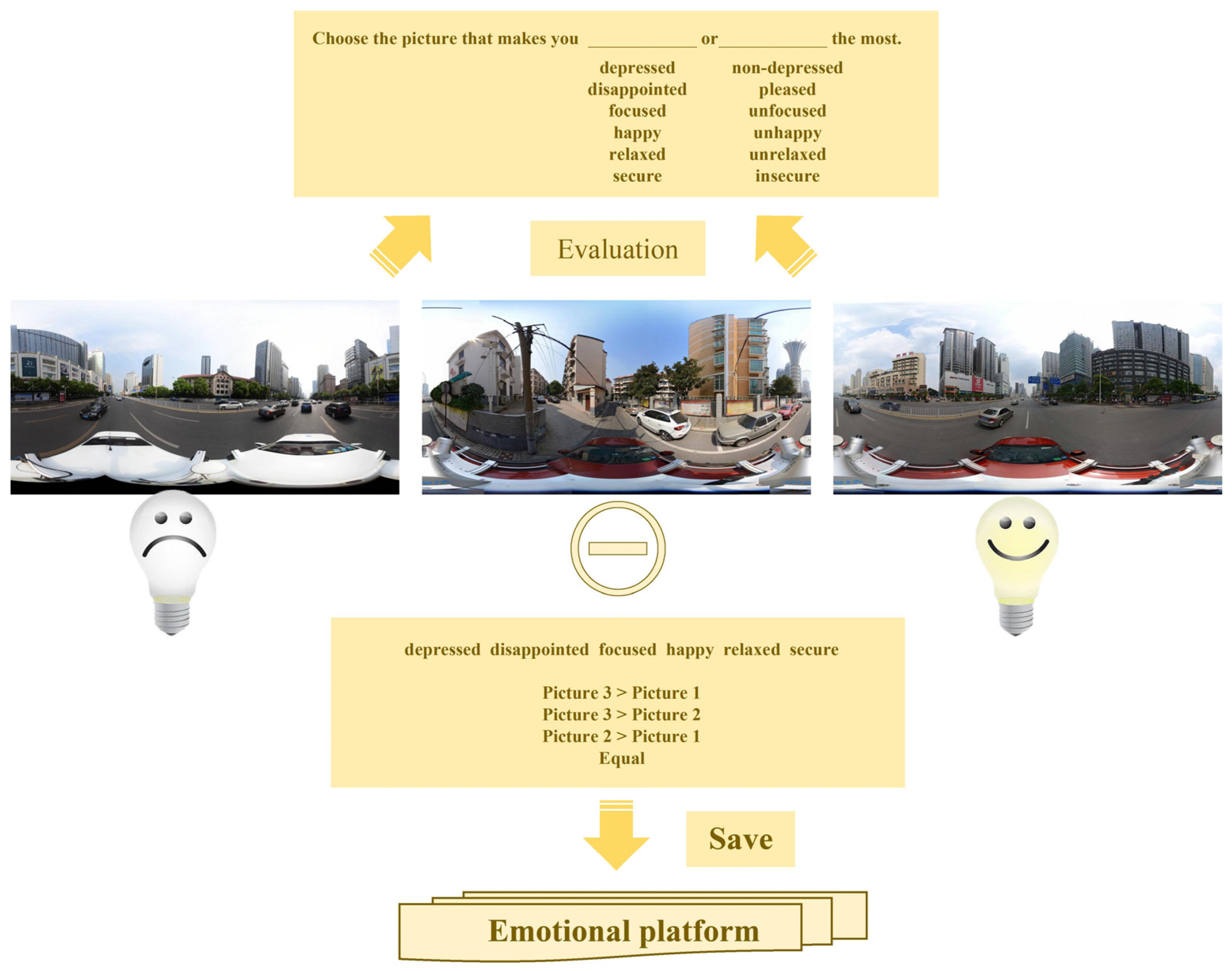

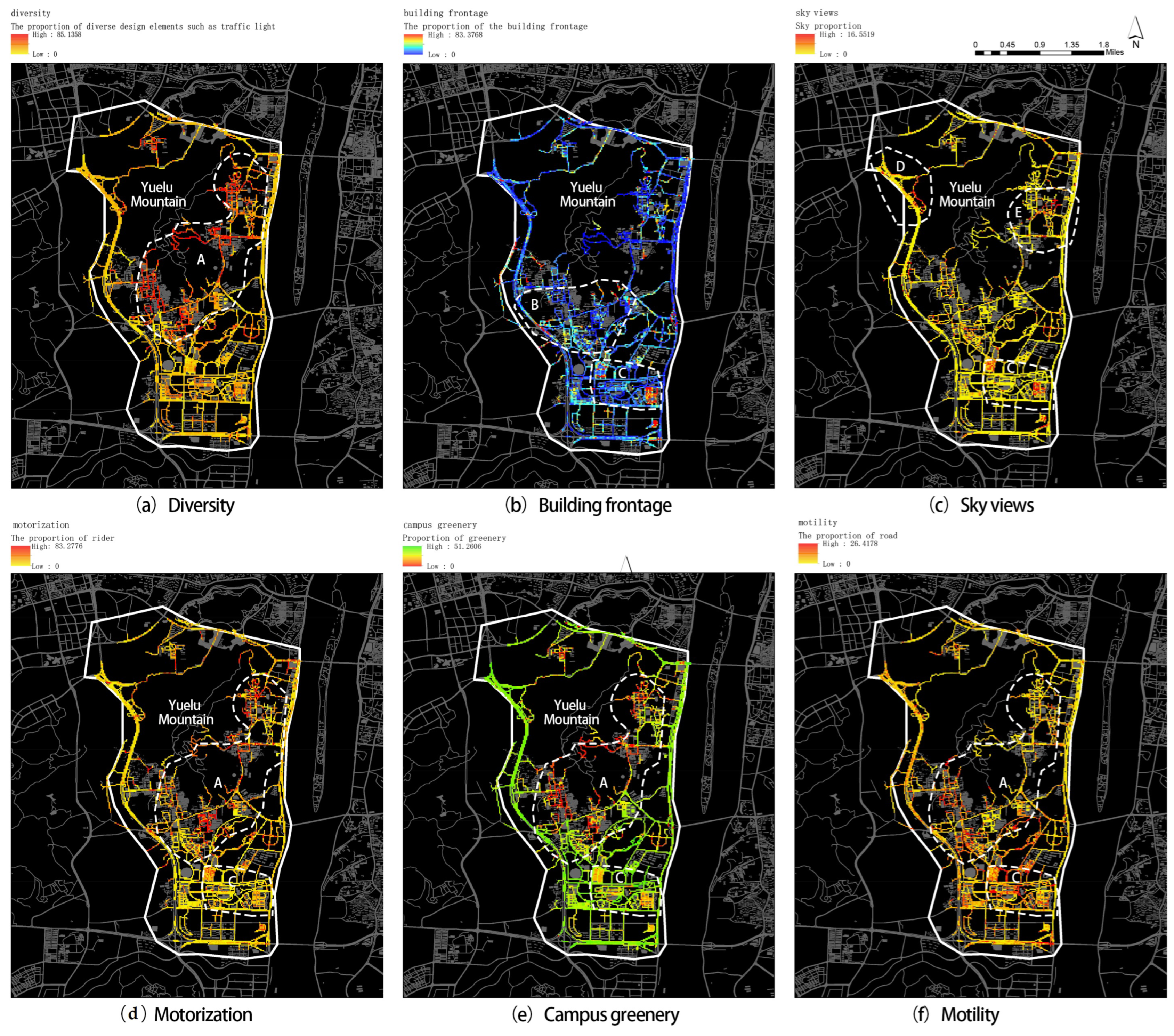



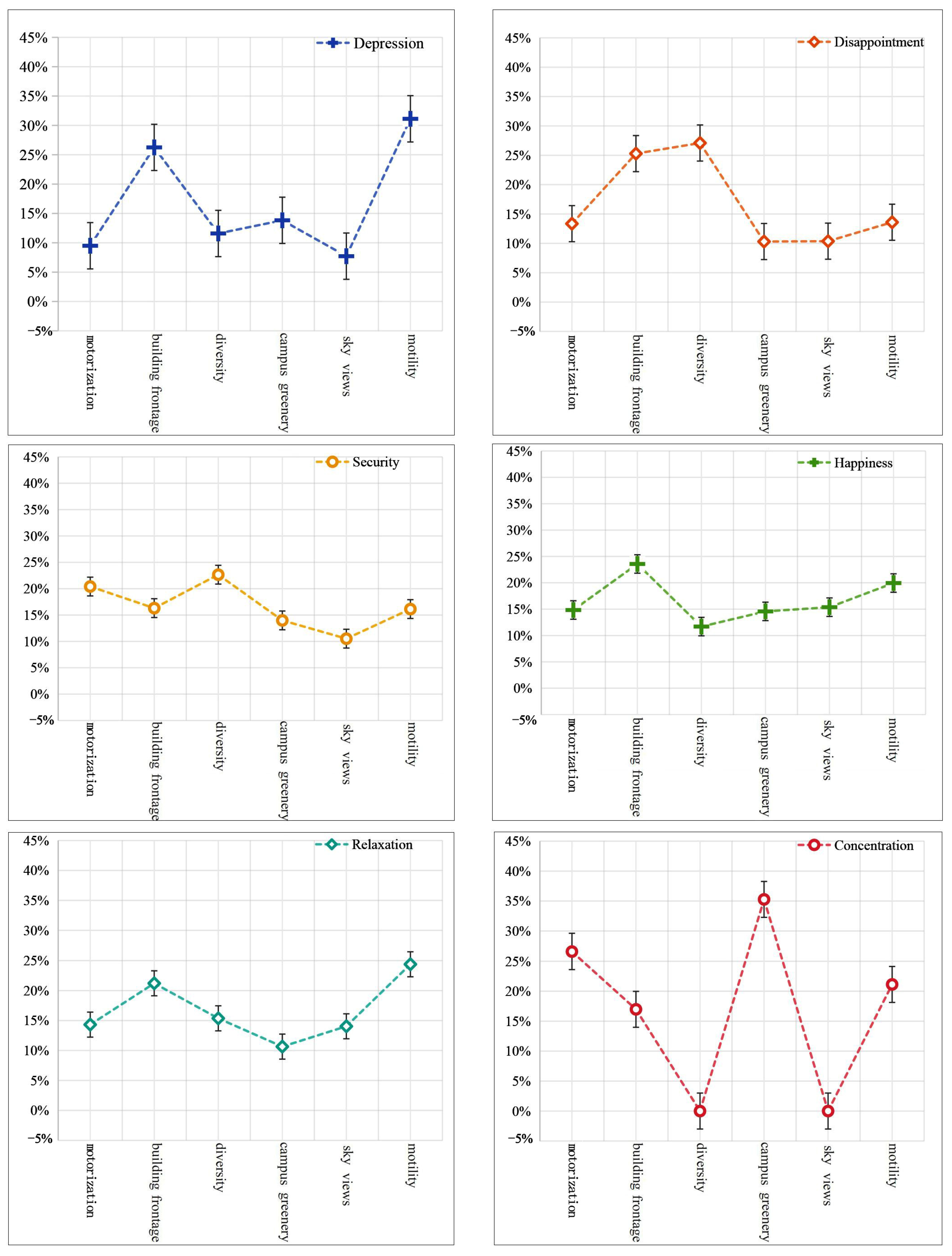
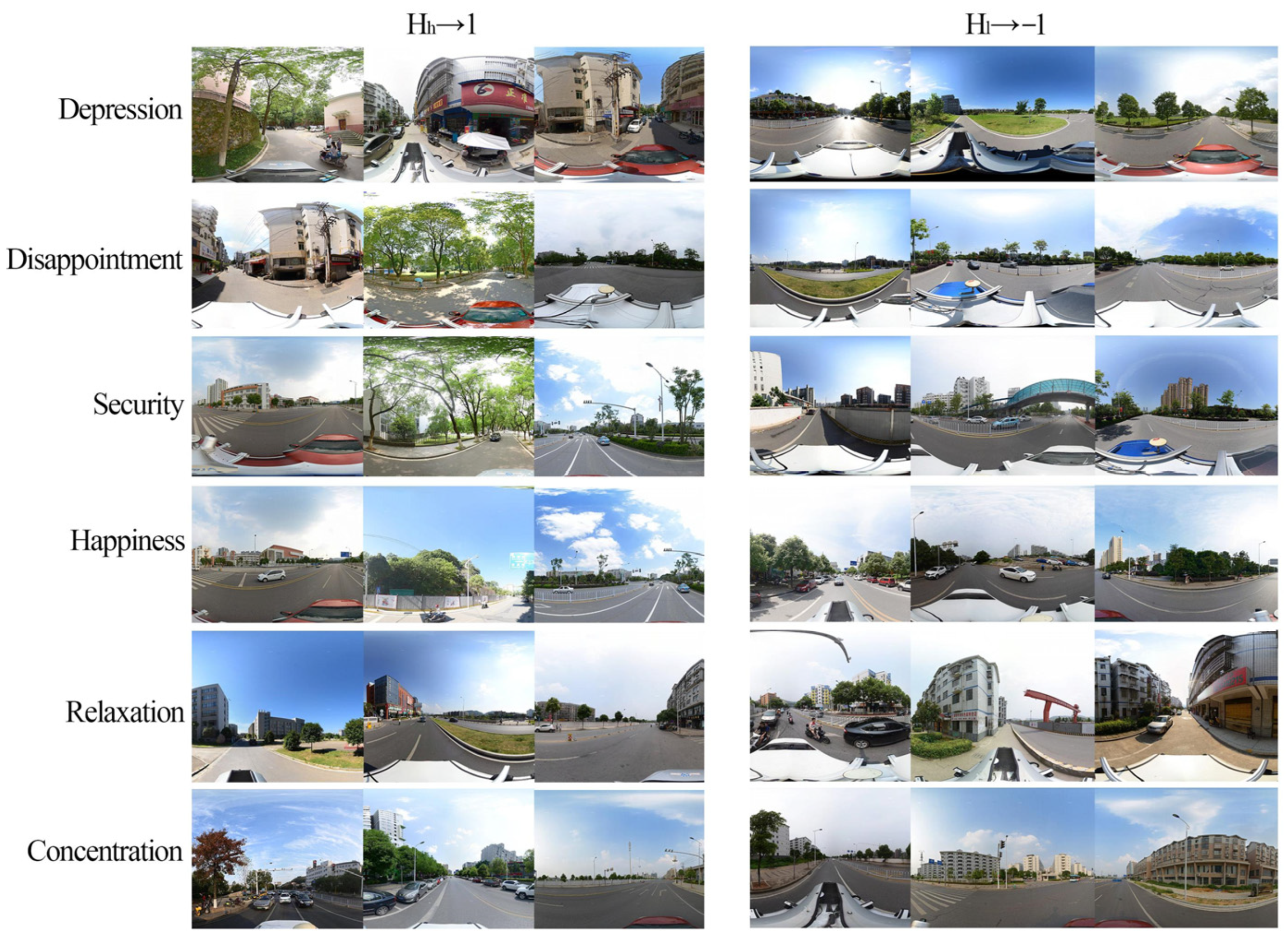
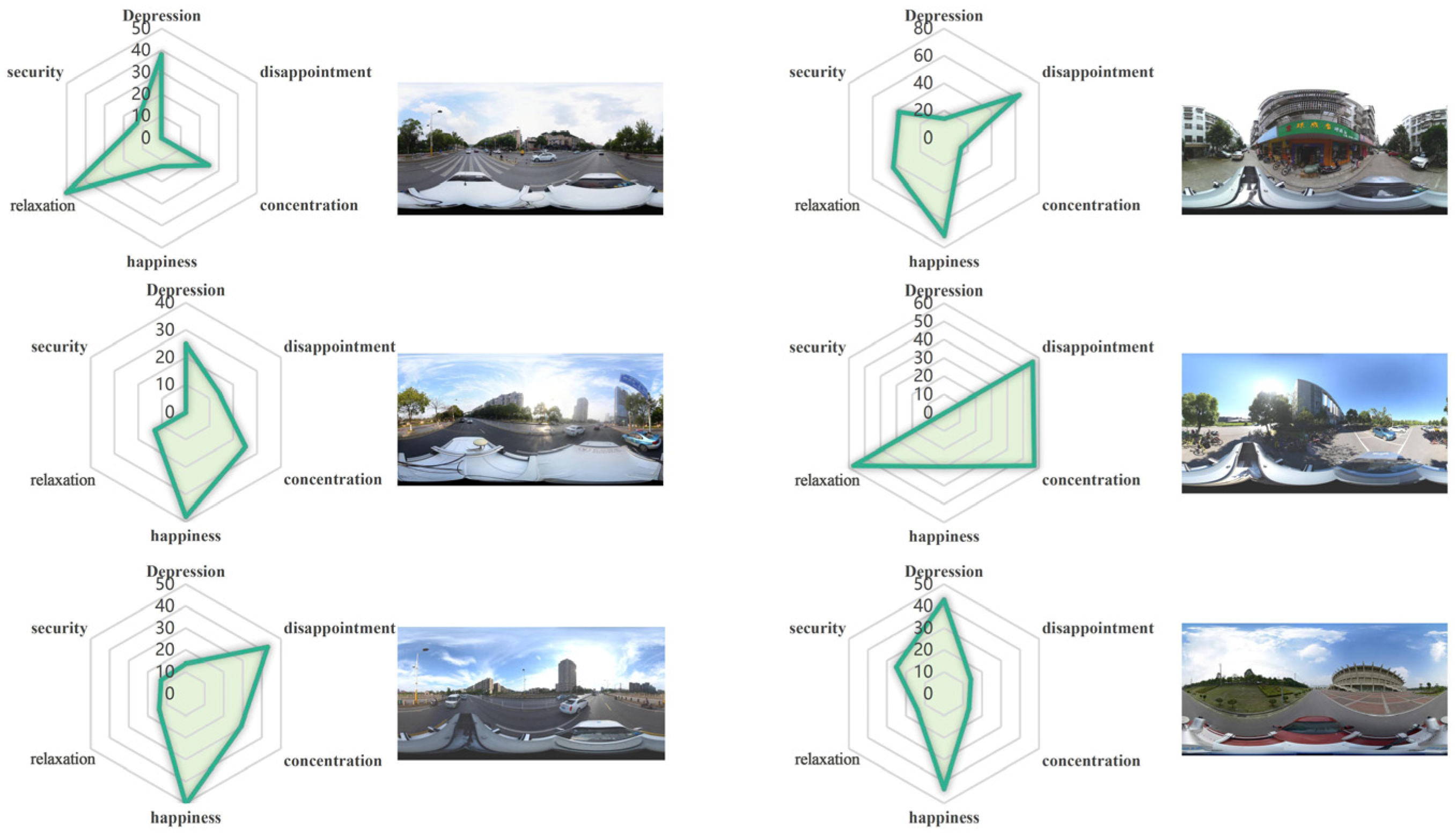
| XGBoost | Random Forest | KNN | BP Neural Network | |
|---|---|---|---|---|
| Accuracy (%) | 70.61 | 60.40 | 60.75 | 62.07 |
| Security | Depression | Disappointment | Relaxation | Happiness | Concentration | |
|---|---|---|---|---|---|---|
| Accuracy (%) | 70.45 | 75.79 | 69.89 | 77.42 | 68.75 | 61.36 |
| Precision (%) | 67.39 | 78.57 | 65.90 | 76.60 | 71.42 | 60.42 |
| Recall (%) | 73.80 | 70.21 | 69.04 | 78.26 | 68.63 | 65.91 |
| F1 (%) | 70.45 | 74.15 | 67.44 | 77.42 | 70.00 | 63.04 |
| Z-Score | p-Value | Confidence Level |
|---|---|---|
| <−1.65 or >+1.65 | <0.10 | 90 percent |
| <−1.96 or >+1.96 | <0.05 | 95 percent |
| <−2.58 or >+2.58 | <0.01 | 99 percent |
| Global Moran’s I Index | p-Value | Z-Score | Confidence Coefficient | Pattern | |
|---|---|---|---|---|---|
| Happiness | 0.173687 | 0.000000 | 44.972916 | 99 per cent | Clustered |
| Concentration | 0.287764 | 0.000000 | 74.493483 | 99 per cent | Clustered |
| Disappointment | 0.329239 | 0.000000 | 85.226579 | 99 per cent | Clustered |
| Depression | 0.379017 | 0.000000 | 98.107986 | 99 per cent | Clustered |
| Security | 0.164829 | 0.000000 | 42.680497 | 99 per cent | Clustered |
| Relaxation | 0.228221 | 0.000000 | 59.085108 | 99 per cent | Clustered |
Disclaimer/Publisher’s Note: The statements, opinions and data contained in all publications are solely those of the individual author(s) and contributor(s) and not of MDPI and/or the editor(s). MDPI and/or the editor(s) disclaim responsibility for any injury to people or property resulting from any ideas, methods, instructions or products referred to in the content. |
© 2024 by the authors. Licensee MDPI, Basel, Switzerland. This article is an open access article distributed under the terms and conditions of the Creative Commons Attribution (CC BY) license (https://creativecommons.org/licenses/by/4.0/).
Share and Cite
Peng, Z.; Zhang, R.; Dong, Y.; Liang, Z. A Study on the Relationship between Campus Environment and College Students’ Emotional Perception: A Case Study of Yuelu Mountain National University Science and Technology City. Buildings 2024, 14, 2849. https://doi.org/10.3390/buildings14092849
Peng Z, Zhang R, Dong Y, Liang Z. A Study on the Relationship between Campus Environment and College Students’ Emotional Perception: A Case Study of Yuelu Mountain National University Science and Technology City. Buildings. 2024; 14(9):2849. https://doi.org/10.3390/buildings14092849
Chicago/Turabian StylePeng, Zhimou, Ruiying Zhang, Yi Dong, and Zhihao Liang. 2024. "A Study on the Relationship between Campus Environment and College Students’ Emotional Perception: A Case Study of Yuelu Mountain National University Science and Technology City" Buildings 14, no. 9: 2849. https://doi.org/10.3390/buildings14092849






